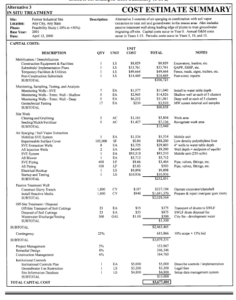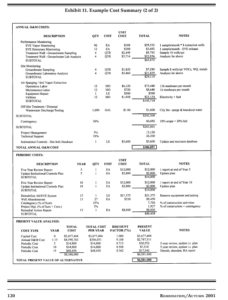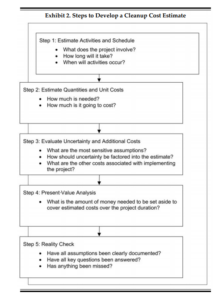Understanding the relationship between the environment, society and the economy is key to producing sustainable solutions for environmental remediation of the Easton Iron Works sites. The City of Easton, having ownership of the property, is eligible for grants that would be out of reach for non-profit or other organizations. This allows for more of the budget to come from grants rather than from out of pocket or donations. There are different costs associated with environmental cleanup that are often sourced from different stakeholders such as the city, state, and federal governments. In our economic analysis of the Easton Iron Works site we will explore different aspects of externalities, cost-benefit analysis of environmental remediation, the economics behind waste management & land cleanup, as well as the valuation that environmental cleanup provides to the community. Understanding the different costs and benefits associated with the Easton Iron Works environmental reclamation project is key to producing a solution that is equitable for the community.
The main financing behind this project is sourced from the Industrial site reuse program, which is run by the state of Pennsylvania to carry out site assessments and remediation at former industrial sites. They provide loans and grants ranging from $200,000 to $1,000,000. These loans and grants have an interest rate of 2% with periods for assessment of 5 years and 15 years for remediation projects. The City of Easton has received the maximum loan of $1,000,000 for the Easton Iron Works cleanup and will have to match the value of the loan by 25%. Dave Hopkins, Director of public works for the city, states, “The City received the maximum grant amount of $1 million through the ISRP program.” Environmental cleanup projects are expensive due to the research and planning that has to take place to make accurate assessment of the environmental quality of the site. Because Easton is receiving funding from the state, Pennsylvania will have guidelines for remediation and Easton cannot move forward with their plans until approved by the state.
There are different challenges that our capstone project group faces when we are performing an economic analysis. While we can set up different methods such as cost estimation for the environmental reclamation of the Easton Iron works site, it is difficult for us to come up with hard numbers due to the lack of information we have pertaining the cost of the different processes for environmental cleanup. Every environmental cleanup project is unique depending on many different factors such as location, size, level of contamination, and scope of the project. “Developing a cost estimate early in the process with limited information is one of the most difficult tasks to perform well” (EPA, 2000). Because the project is still in its early stages developing an accurate cost estimate is not feasible right now; however, developing and analyzing the proper steps to do so will provide valuable information to the stakeholders involved in the environmental cleanup project. “Wrong” cost estimates often occur due to not well thought out assumptions and project scope used to develop the estimate (EPA, 2000). In order to have a successful cost estimate it is important that it is defensible and reproducible.
This project is an investment by the City of Easton in order to improve the environmental quality of the groundwater and develop a public space to serve the community. The City of Easton is responsible for the purchase of the iron works site as well as carrying out the necessary tasks to perform environmental remediation. The investment in the project will be sourced from the Industrial Site Reuse Program as stated before, this is where Easton will get the funding for the investment. Investment to improve environmental quality is different than for example investment in infrastructure because their benefits usually go unnoticed. There are oftentimes more pressing issues within communities that take priority over environmental issues, so it is hard to source funding for these types of investments. However, as industry continues to develop it is paramount that we address environmental concerns that we have started. Environmental cleanup is the first necessary step to take place before any sort of community development project can take place.
There are different steps to making an accurate cost analysis of an environmental cleanup project. The EPA provides information as to how to carry out a cost analysis of cleanup outlined in their “guide to developing and documenting cost estimates during the feasibility study.” According to this document steps to developing a cost estimate include: estimate activities and schedule which considers what activities will take place and length of project. Estimate Quantities and Unit costs; how much is needed? How much is it going to cost? Evaluate Uncertainty and additional costs; what are the most sensitive assumptions? Present Value Analysis; What is the amount of money needed to be set aside to cover estimated costs over the project duration? Reality check; Has anything been missed? Are the assumptions correct? (EPA, 2000) Considering all of these aspects of cost analysis is important to creating an accurate estimate of costs. The documents further down in the analysis provides an example of what a cost estimate summary would look like for an environmental remediation project (Figures 6.1, 6.2).
Costs associated with the environmental remediation at the iron works site fall into different categories. These categories help determine at which times of the project duration costs would be incurred.
- Initial Activities
-
-
- Mobilization/Demobilization
- Monitoring, Sampling, Testing, and Analysis
- Site Work
- Off-Site Treatment/Disposal
- Project Management
- Remedial Design
-
- Annual Activities
-
-
- Performance Monitoring
- Site Monitoring
- Technical Support
-
- Periodic Activities
-
- Comprehensive Remedy Reviews
- Well Abandonment (at project completion)
- Remedial Action Report
(EPA, 2000)
Creating an accurate cost estimate is important when completing our economic analysis for the Easton Iron Works bioremediation, an example of this is seen in Figure 6.1. Cost estimates are typically weighted heavily when making cleanup decisions and thus their accuracy is very important. The first part of the cost estimate summary would include initial activities or capital costs, one-time fixed costs associated with the project. Costs associated with construction would include the demolition of buildings as well outsourcing the proper equipment to perform this and hiring the correct personnel such construction managers and laborers. Another cost associated with the demolition would be the disposal of waste in the site which would require dump trucks to move the waste off site. More costs are associated with the beautification of the site such as hiring landscapers to provide clearing and grubbing services as well as planting of seeds, mulch and fertilizer. Another important capital cost would be the implementation of monitoring the soil this would include: sampling, testing, and analysis of the soil. Associated with this step would also be the construction and purchasing of monitoring wells as well as geotechnical testing of the soil and earth in the site. Another capital cost that would be expensive is contingency, money set aside in case of unforeseen expenses of the project. The cost of initial activities are often the most expensive when compared to annual and periodic costs.
The other part of creating a cost estimate summary is calculating the annual operating and maintenance costs of the project. These costs include expenses such as annual site monitoring and analysis to ensure remediation efforts are being made throughout the duration of the project. Other annual costs would include maintenance labor, operations labor, landscape upkeep, and equipment repair. These costs are necessary to ensure project success throughout the duration of the cleanup.
The last part of creating a cost estimate summary is to consider the periodic costs. These costs occur at different times throughout the project. These would include things such as reports due at specific time intervals depending on city and state guidelines in order to document environmental remediation progress. These reports might be required every few years until the contamination is completely removed and there is no more need for them. Another periodic cost would be the removal of monitoring wells and equipment once environmental remediation is complete. By creating this sort of detailed cost estimate summary it allows the city and other stakeholders to get a realistic idea of what kind of money is needed to complete a successful project for the bioremediation of the Easton Iron Works site.

Figure 6.1: Cost Estimate Summary for In Situ Treatment (EPA, 2000)

Figure 6.2: Cost Estimate Summary for In Situ Treatment (EPA, 2000)

Figure 7: Flowchart surrounding steps for cleanup cost estimate
Using the cost estimate criteria seen in Figure 7 for the Easton Iron Works cleanup project we can develop a summary for the costs associated with the cleanup. When we consider the first step “estimate activities and schedule” the Easton Iron Works will require the demolition of the existing buildings that will occur in the next 6-8 months according to Dave Hopkins. After this step environmental remediation can begin through the detail provided on bioremediation provided in the technical analysis section above.
The “Estimating Quantities and Unit cost” step is tricky to determine given our lack of knowledge of specific quantities and prices of operating and maintenance activities. In order to get this information we would need quotes from vendors or construction contractors can provide costs that are more site-specific in nature than costs taken from standard guides and references. (EPA, 2000).
The next step “evaluating uncertainty and additional costs” involves a sensitivity analysis that could focus on factors that have a relatively high degree of uncertainty and that, with only a small change in their value, could significantly affect the overall cost of the project (EPA, 2000). For the Easton Iron Works these uncertainties could be unforeseeable costs that are likely to become known as the remedial action construction or O&M proceeds. Examples include changes due to adverse weather, material or supply shortages, or new regulations. (EPA, 2000). Because this project has yet to take place it can be hard to estimate these uncertainties until the project actually begins.
The next step for producing a cost estimate is present value analysis. For the Easton Iron Works site we would have to set a time period for the analysis which should be equivalent to the project duration. After determining this we would have to calculate the cash outflows for each year of the project as well as determining a discount rate to account for the time value of money. Lastly, with this information we could calculate the present value of the Easton Iron Works remediation project.
The last step in the cost analysis is taking a “reality check” to ensure that nothing is missing and reviewing calculations. Assumptions for the Easton Iron Works sites would involve the idea that the contaminated groundwater can be cleaned up in a timely manner and is feasible.
The EPA outlines different questions to be answered to create an accurate “reality check” these include:
- Has a description of the alternative been provided?
- Have the initial, annual, and periodic activities of the alternative and associated capital and O&M costs been identified?
- Have quantities for activities been estimated with sufficient backup? 4. Have unit costs for activities been estimated with sufficient backup?
- Has contingency been applied to the total of initial, annual, and periodic activities costs? 6. Have other costs been added appropriately?
- Were guidelines followed for the present-value analysis?
- Is there sufficient uncertainty for key factors to warrant a sensitivity analysis? If a sensitivity analysis was done, are results presented clearly in terms of total present value of the alternative?
(EPA, 2000)
After completing a cost analysis is it important to consider potential benefits from the environmental remediation project. In order to do so we must “consider cleanup activities, mitigating these problems can increase well-being by improving human health and amenities, restoring ecosystems, and reversing materials damages” (EPA, 2011).
The EPA outlines different categories of benefits from environmental remediation projects.
- Human Health benefits
-
-
- Morality
- Morbidity
-
- Ecological Improvements
-
-
- Market Products
- Recreational activities and aesthetics
- Valued ecosystem functions
- Non-use values
-
- Other benefits
-
- Aesthetic improvements
- Reduced materials damages
- Land productivity improvements
(EPA, 2011)
A large benefit for the Easton Iron Works remediation is human health benefits which for environmental cleanup projects commonly includes a reduced risk of mortality from illness and acute fatalities, and reduced morbidity risk from asthma, nausea, cancer, birth defects, adverse reproductive or developmental disorders, and other illnesses or injuries (EPA, 2011). Humans can be affected from environmental contamination through different avenues such as air, water and soil. Once the land is cleaned up humans living around the site can experience health benefits. These improvements would directly benefit community members of Easton.
Another benefit from environmental cleanup is ecological benefits which pertains to the migration of contamination that affects wildlife and ecosystem productivity (EPA, 2011). The environmental cleanup will likely increase land productivity meaning the land that is remediated will have an increased property value and there will be opportunities for different land uses that can benefit communities. The cleanup of unattractive and hazardous sites provide benefits to non-market goods such as recreational activities and aesthetic enjoyment. These are important in the case of the Easton Iron Works site as it will likely be used as a continuation of the Karl Stirner Arts Trail which the members of Easton frequently use as a space for different activities. The additions that the iron works site can provide for the arts trail might attract more community members to use the new space.
In the case of the Easton Iron Works site, land cleanup efforts that target abandoned or vacant properties increase the quantity of developable land that can then be put to its highest valued use (EPA, 2011). This project has the ability to promote other land cleanup projects and the preservation of other greenspaces. The net benefits can be calculated by comparing the difference between the value of the site before and after environmental cleanup and redevelopment (EPA, 2011). This can be used in economic analysis to see if the investment to cleanup and improve the site was justified and can possibly promote motivation for other environmental cleanup projects around the community.
The City of Easton has plans to reuse the Iron Works land to become part of the Karl Stirner Arts Trail. Jim Toia, Director of Arts Board, states, “It is very exciting to know that we are going to have the opportunity to turn this property into public space and beautify an area and make it available to the entire community. That is really important to us.” When performing an economic analysis it is important to consider the benefits of the project to provide justification for the costs associated with environmental remediation. It is often hard to quantify these benefits in terms of dollar amounts; however, understanding the scope of benefits can provide insight into the community benefits and potential for profit after the project is completed.
Understanding the costs and benefits of the Easton Iron Works remediation project are paramount to creating a successful study. The EPA has many documents pertaining to economic analyses of environmental projects that provide important insights for the case of the Easton Iron Works remediation. Money is often a deciding factor when it comes to making decisions about projects and thus understanding the scope of the economics behind this project is quite important.